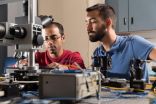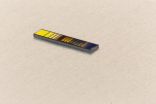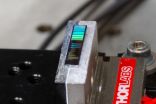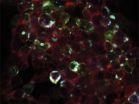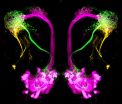(Press-News.org) A team of researchers from the University of California, San Diego have demonstrated a way to emit and control quantum light generated using a chip made from silicon--one of the most widely used materials for modern electronics.
The UC San Diego researchers recently described their new device's performance online in the journal Nature Communications, available via Open Access .
The researchers say practical applications of quantum optics will seem more feasible if devices for generating and controlling these photons can be manufactured using conventional materials from the semiconductor industry such as silicon. These devices could have applications in secure communications, precise measurements of motion or shape, and sensing using ultra-low levels of light.
For instance, the researchers suggest that their silicon pair-generation chip could be used as part of a more complicated "quantum transceiver" module, which would eventually integrate a controllable photon source with a sensitive photon detector in a single package.
"Optical transceivers have revolutionized data communications, and tens of millions of these devices are used to send billions of bits of data all over the internet and inside data centers every second," said Shayan Mookherjea, an associate professor of electrical and computer engineering at the UC San Diego Jacobs School of Engineering. "But these transceivers contain lasers that are made using compound semiconductors, not silicon--which would be more manufacturable and cheaper.
The fact that silicon can be used to make a quantum photonic pair source, and that its spectral properties can be fine-tuned easily is exciting from a technological point of view."
"Silicon is known to be a poor light-emitting material--there is no silicon diode laser, for example, despite many decades of research," added Mookherjea. "However, if you want to make a chip that emits quantum light such as pairs of single photons which are entangled in some quantum mechanical properties and you want to do it at room temperature so that the chip can be widely used, then it turns out that silicon is actually quite a good material for generating photons."
How the Nanophotonic Chip Works
"A beam of light from a laser diode is shone into the chip, and for each pair of photons from the input beam that is absorbed by the material, a pair of photons is
produced at two slightly different frequencies--one higher than the input and the other lower than it, such that the total energy is conserved," explained Marc Savanier, a postdoctoral researcher with the Micro-Nano-Photonics research group at the UC San Diego Jacobs School of Engineering. "Our chip is compact--only millimeters in size--and it works at room temperature, and only requires a simple telecommunications-grade low-power laser diode as the input, and filters to separate the two daughter photons from their parent beam."
Spontaneous Optical Nonlinear Mixing (SONM), the process of photon creation exploited by the researchers in their device, has been shown in a number of different materials such as glass fibers, crystals, and semiconductors like silicon.
"One thing you have to do, though, is to pattern the silicon into waveguides and micro-resonators which enhance the optical intensity at specific wavelengths," said Savanier. "These features are less than a micrometer in height and width--far less than the thickness of a human hair, for example. A piece of silicon by itself is not going to have a very high SONM coefficient and it won't generate a measurable number of entangled photon pairs."
Varying the Spectrum of the Photon Pair
When a silicon chip is patterned using a process called lithography, features that resemble ridges and valleys are permanently etched into the surface of silicon and many of the properties of the device are fixed. The UC San Diego researchers showed that a particular type of patterned structure allows the quantum mechanical properties of the photon pair to be changed over a wide range, by varying a few simple experimental parameters.
"For example, by varying the chip temperature by only a few degrees, we can tune the degree of entanglement by more than a factor of three, as measured by a typical metric called the Schmidt number," said Ranjeet Kumar, an electrical engineering graduate student at UC San Diego and lead author of the paper. "A low Schmidt number represents a device generating photon pairs that has been tuned for a particular quantum optic property called heralding, whereas a high Schmidt number shows that the device generates photons which can be used to encode more than a single quantum bit of information per photon."
"Our device can be tuned over a wide range of Schmidt numbers, whereas other photon pair sources generally cannot, or require complicated additional apparatus to do so--typically thousands of times larger in size than our chip," Kumar said.
In their work, the researchers show how the degree of entanglement is related to a measurement called the Joint Spectral Intensity (JSI), and describe a technique for measuring the JSI experimentally using single photon detectors.
"Previously, controlling the JSI of a photon pair source required a large assembly of optical components on an optical table, and painstaking alignment of spatial light modulators, cylindrical lenses and mirrors" said Savanier. "This made the photon- pair source apparatus bulky, vibration-sensitive, expensive, and not portable. The unique structure of our chip makes this process much simpler, more compact and lightweight."
The researchers showed that the JSI of the chip can be varied by tuning the temperature of the chip by a few degrees, using compact thermo-electric controllers like those typically used with practical opto-electronic microchips. Alternatively, a typical distributed feedback laser diode used as a pump can tune its wavelength over a few nanometers, which can also alter the JSI.
INFORMATION:
Jun Rong Ong, also of UC San Diego, joined Kumar, Mookherjea and Savanier as a co- author on the paper. The research was funded by the U.S National Science Foundation and the U.S. Defense Advanced Research Projects Agency.
It's the most basic of ways to find out what something does, whether it's an unmarked circuit breaker or an unidentified gene -- flip its switch and see what happens. New remote-control technology may offer biologists a powerful way to do this with cells and genes.
A team at Rockefeller University and Rensselaer Polytechnic Institute is developing a system that would make it possible to remotely control biological targets in living animals -- rapidly, without wires, implants or drugs.
Today (December 15) in the journal Nature Medicine, the team describes successfully ...
BOSTON (Dec. 16, 2014) -- Extra vitamin E protected older mice from a bacterial infection that commonly causes pneumonia. Microbiologists and nutrition researchers from Tufts University report that the extra vitamin E helped regulate the mice's immune system. The findings, published online in advance of print in the The Journal of Immunology, show promise for studies investigating the effects of vitamin E and infection in humans.
Older adults over age 65 are at high risk for developing pneumonia, an inflammation of the lungs typically caused by infection. The most common ...
A scientific team at UBC and Providence Health Care have genetically engineered mice with less wrinkled skin, despite repeated exposure to wrinkle-inducing ultraviolet (UV) light.
The youthful-looking mice were bred without the gene that produces Granzyme B, an enzyme that immune cells use to destroy harmful pathogens. The UBC-Providence team, led by Professor David Granville and postdoctoral fellow Leigh Parkinson, found that Granzyme B also does harm: When produced and released by skin cells in response to UV light, it triggers the breakdown of collagen, a structural ...
ANN ARBOR--A set of eight hurricane-forecast satellites being developed at the University of Michigan is expected to give deep insights into how and where storms suddenly intensify--a little-understood process that's becoming more crucial to figure out as the climate changes, U-M researchers say.
The Cyclone Global Navigation Satellite System is scheduled to launch in fall 2016. At the American Geophysical Union Meeting in San Francisco this week, U-M researchers released estimates of how significantly CYGNSS could improve wind speed and storm intensity forecasts.
CYGNSS--said ...
Contrary to popular belief, new research suggests that some employees adapt well to pressures caused by changes in the workplace.
Pay cuts, reduced working hours, fewer training and promotion opportunities are just a few of the measures organisations employ to combat economic downturn and industry competition. Where previous research has suggested cut backs result in a demotivated and unhappy workforce, experts from Monash University and The University of Iowa say this might not necessarily be the case.
A new study published in the Journal of Occupational and Organizational ...
A global fleet of composite planes could reduce carbon emissions by up to 15 percent, but the lighter planes alone will not enable the aviation industry to meet its emissions targets, according to new research.
The study, by the Universities of Sheffield, Cambridge and UCL (University College London), is the first to carry out a comprehensive life cycle assessment (LCA) of a composite plane, such as the Boeing Dreamliner 787 or Airbus 350, and extrapolate the results to the global fleet.
The LCA covers manufacture, use and disposal, using publicly available information ...
A team of Chinese and Italian scientists has joined efforts to provide a key to the understudied phaleratus group of blister beetles. During their research the scientists have also discovered a new species from the genus Hycleus, which they named after Marco Polo, as a tribute to their collaboration during the Ph.D. studies. The study was published in the open access journal ZooKeys.
The phaleratus group to which the new species Hycleus marcipoli belongs, is part of the Meloidae family commonly known as the blister beetle family. The representatives of this group get ...
This news release is available in German. Whether an odor is pleasant or disgusting to an organism is not just a matter of taste. Often, an organism's survival depends on its ability to make just such a discrimination, because odors can provide important information about food sources, oviposition sites or suitable mates. However, odor sources can also be signs of lethal hazards. Scientists from the BMBF Research Group Olfactory Coding at the Max Planck Institute for Chemical Ecology in Jena, Germany, have now found that in fruit flies, the quality and intensity of ...
Researchers studied 414 people with severe dementia along with their carers in England, Estonia, Finland, France, Germany, the Netherlands, Spain and Sweden. The study gathered information on quality of life, activities of daily living such as bathing, feeding and dressing and presence of depressive symptoms using standardised measures.
In the groups studied, 37% of the 217 people living in the community showed signs of depression compared to 23% of the 197 in care homes. It is one of the few studies comparing similar groups of people living at home and in nursing homes.
Professor ...
Some neurons are more active than others, even when they are positioned right next to each other and are one and the same neuron type. Dr. Jean-Sébastien Jouhanneau and Dr. James Poulet of the Max Delbrück Center for Molecular Medicine (MDC) Berlin Buch have discovered the cause for this phenomenon. They found that the more active neurons in the somatosensory area of the brain respond to a broader receptive field and probably play a particularly important role in our sensory perception. The findings of the researchers, who also work at the NeuroCure Cluster of ...
